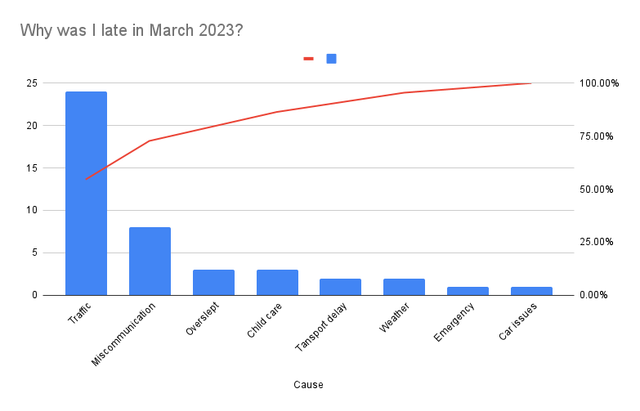What if you could do less and be more productive at the same time? Learn how to prioritize tasks and allocate your resources more effectively using Pareto analysis.
If you’ve ever felt overwhelmed by problems that all seem to require your immediate attention, you might want to consider using the Pareto analysis. This business management tool can be incredibly useful in everyday life. It can help you understand where you should spend your time in order to achieve your goals and fix problems. We’ll explain how Pareto analysis can increase your productivity.
What Is the Pareto Principle?

(Foto: CC0 / Pixabay / balouriarajesh)
In 1896, Italian economist Vilfredo Pareto discovered that 20% of the population in Italy controlled 80% of the country’s land. He later carried out more research and made an astounding discovery that only 20% of his garden’s pea plants produced 80% of the peas. And this is how the Pareto rule of 80/20 came to be. According to it, 80% of the result comes from 20% of the input.
In 1941, management consultant Joseph M. Juran began using Pareto’s concept to address quality concerns in business management. He used the phrase “vital few” to describe the main 20% of the factors contributing to the problem and called the remaining 80% “useful many”, emphasizing that even the least impactful issues shouldn’t be completely ignored.
Later research confirmed that the Pareto principle applies to many real-life situations with remarkable accuracy. For example, a 2002 report from Microsoft found that “80% of the errors and crashes in Windows and Office are caused by 20% of the entire pool of bugs detected.”
Pareto Analysis Step-by-Step



(Foto: CC0 / Pixabay / StockSnap)
Pareto analysis is a decision-making tool used in business management. Based on the 80/20 rule, it seeks to pinpoint the 20% of problems that cause 80% of either good or unpleasant outcomes. It helps allocate existing resources more efficiently.
This is how you carry out a Pareto analysis in 5 steps:
- Identify the problems you wish to solve.
- Make a list of the issues that cause these problems.
- Score the problems based on the negative impact they have on the outcome. This score can be based on how often they occur in a chosen time frame, how much time you spend fixing them, or how many resources they use.
- Group the problems that have the same root cause and add up the scores to identify the group that should be your priority.
- Develop an action plan focusing on the high-ranking problems first.
The result of the analysis is usually visualized in a Pareto analysis chart. It looks similar to a typical bar chart, with vertical bars representing various problems and a cumulative percentage curve representing the cumulative impact of these problems on the outcome. If made correctly, a Pareto chart helps to determine the course of action and the order in which issues need to be tackled.
Using Pareto Analysis in Everyday Life



(Foto: Utopia / A.Zaripova)
There are many real-life situations where focusing on the “vital few” can have the best payoff. Here are just a few examples of how you can use Pareto analysis in your daily life:
- Organize your workday. According to the 80/20 principle, 80% of the result come from 20% of the tasks you complete each day. To be more productive, use Pareto analysis to identify these tasks and deal with them first before you get tired.
- Develop healthy habits. Are you unsuccessfully trying to exercise regularly, eat healthily or learn a new skill? The Pareto principle teaches us that 80% of your failure is caused by 20% of the reasons. Use Pareto analysis to determine which issues you should tackle first for the best outcome.
- Save money. If you are trying to save money, it seems natural to start spending less on everything you buy. However, we typically have 20% of our monthly spending represent 80% of our total budget. You can use Pareto analysis to strategically explore the cost-saving potential in these key areas.
Using Pareto analysis helps to sharpen problem-solving and decision-making skills. It teaches you to strategically prioritize the most critical issues instead of trying to fix all of them at once. As a result, you can use your time and resources more productively.
Limitations of the Decision-Making Tool



(Foto: CC0 Public Domain / Unsplash - Austin Distel)
Like any other tool, Pareto analysis has limitations you need to keep in mind.
- It won’t solve your problem for you or tell you how to fix the main issues once you determine them.
- It typically just takes into account a problem’s frequency rather than its severity.
- It analyzes past data, but the outcome in the future can be completely different.
Once you start applying Pareto analysis in your daily life, you might notice that the 80/20 ratio is not always precise. Don’t be confused, since these numbers are just a benchmark. Listing every single issue that affects the outcome is not always easy. You need to be completely honest with yourself while thinking about the root causes of the problem you are facing. If you ignore some of them, you might end up wasting your time.
Note that Pareto analysis might not be useful in some situations, such as when the most impactful factors are out of your control. You must test it out for yourself to determine where it can be useful in your life.
Read more:
- 10 Productive Things to Do Instead of Scrolling Through Your Phone
- How to Get Rid of Brain Fog Naturally: Tips for Clearer Thinking
- Bare Minimum Monday: Mental Health Hack or Just a Trend?
Do you like this post?








